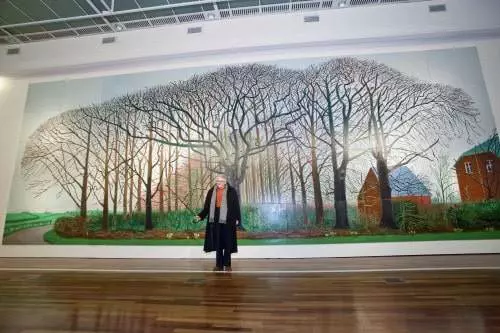
Guest blog post by Alison McIntyre
David Hockney has been a hero of mine, and no doubt lots of other people, since I was a teenager. So I was very excited about going to see Bigger Trees Near Warter (it’s a village between York and Driffield, not a typo!) at York Art Gallery, especially as this part of Hockney’s career is one I’m particularly excited about.
Hockney has fairly recently moved back part-time from the west coast of America and devotes his time here to painting the Yorkshire Wolds – the low hills in East and North Yorkshire. He paints outside on canvas, often at the side of the road after having driven around for hours looking for the perfect composition. He paints all year round and the paintings map the changing landscape with trees as a particular focus – when trees are cut down he paints the felled trees! There is a fantastic documentary about these paintings called A Bigger Picture by Bruno Wollheim, which you can watch at the gallery.
When I entered the room I was completely blown away by the size of the painting, even though I knew it was going to be big. What struck me next was the feeling of spontaneity it manages to convey, despite the fact that it was meticulously planned and took six weeks to complete – in Hockney’s words, “You’ve really got to prepare if you’re going to be spontaneous”. I think it achieves this spontaneity because each individual canvas is spontaneous in itself. To understand this and to really appreciate the picture you need to know a little about how it was created.
Lots of people, including myself with school kids and Rolf Harris in Trafalgar Square, have taken a picture, cut it into squares and asked people to re-create a square each. We’ve then put the picture back together like a jigsaw and the effect is striking. Hockney has used a similar technique to produce some fantastic multiple canvas images of the grand canyon.
This painting is uniquely different though. Hockey was outside, he would look at what he planned to paint for ages, then paint it very quickly and spontaneously. His assistant photographed each painting and built up a photo-mosaic of the finished canvasses. Hockney would look at this whilst he was painting, to step back and get the bigger picture, but each canvas was drawn outside from real life, with the adjoining canvasses propped up next to it to make sure they matched (there are errors but they add to the whole rather than detract). Hockney hints at this difference, and his combination of traditional landscape painting techniques with state of the art technology, with an alternative title (a little cryptically in French) Peinture sur le Motif pour le Nouvel Age Post-Photographique – Painting on the Reason for the New Post-Photographic Age
I find this an incredible process, especially as the picture captures the very beginnings of Spring – the daffodils at the front, the trees just beginning to bud, the pink grasses and copse in the distance giving a sense of Spring light – so had to be finished before the real onset of Spring. There are 50 canvasses in total, painted in six weeks so that’s more than one canvas every day and this is Britain – it must have rained on some of those days!
The picture itself swallows you up into it. The more you look the more you see how perfectly each tree, branch, plant and twig are rendered, then stepping back the almost childlike simplicty and spontaneity hits you all over again.
I think this is a truly magical painting and a feat of artistic skill hard to rival. A must see for everyone!